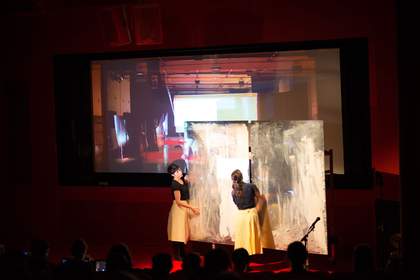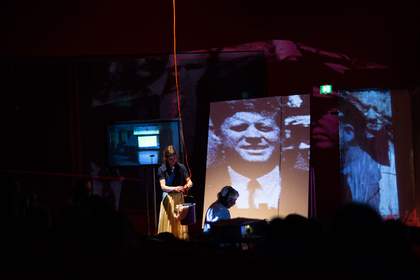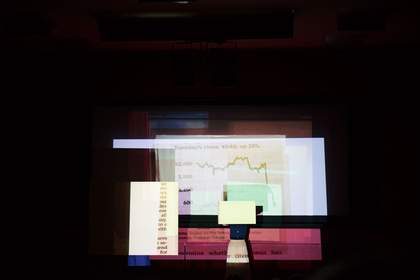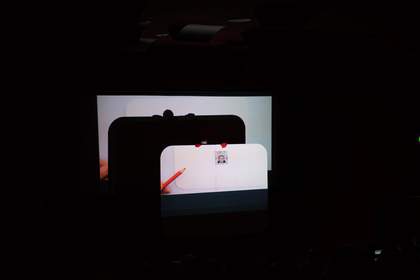Joëlle Tuerlinckx presented her opera-lecture «THAT’S IT!» (+ 3 Free Minutes) at Tate Modern on 4 and 5 April 2014. The piece was developed from the intersection of the artist’s visual and text-based studio archive with a sound archive she had accumulated in collaboration with artist Christoph Fink. A series of multi-lingual texts were played from recordings and read aloud live, alongside a musical score composed by Fink and accompanied by Valentijn Goethals. The result was what Tuerlinckx termed a ‘theatre-laboratory’, with herself as the self-styled chemist.1
Tuerlinckx had selected peers and friends to perform scored movements on stage, involving screens, sheets and objects, and to provide voiceovers of selected texts in different languages, from the lectern at the side of the stage. Her visual archive – consisting of photographs of recognisable people, sketches of objects and scans of press cuttings kept on her computer – was projected onto the central screen, as well as onto secondary side screens, which were created when performers walked across the stage with sheets.
Tuerlinckx manipulated the images by moving the projectors, while in the first rows of the auditorium the audio-visual equipment, including mixers and a number of computers controlling all the digital elements, remained visible throughout. Although the artist was not present on the stage, Tuerlinckx guided the audience through her digital archive, opening and closing folders, files and documents on the computer, which was then projected onto the screen. Tuerlinckx has referred to this action as ‘monstration’, meaning the act of showing the public the structures and stratifications of her archive.2 The soundscapes created and the dance-like movements of her participants constituted the ‘opera’ element of the work, with Tuerlinckx’s ‘monstrations’ comprising the ‘lecture’.
«THAT’S IT!» (+ 3 Free Minutes) created a multi-layered representation of a digital archive. Tuerlinckx played with depth and flatness by overlaying multiple images, actions, sounds and spoken language. While the artist’s explication added texture to the images displayed and the actions of the performers made the usually flat screen three-dimensional, the projection nonetheless remained flat, as other parts of the stage were obscured when bodies or smaller screens got in the way. Tuerlinckx has also said that this performance explored the spatialisation of her own brain; by acting as a guide through an archive she had accumulated throughout her practice, Tuerlinckx exposed her own way of thinking and interpreting the images and sounds. As Tuerlinckx has commented «THAT’S IT!» (+ 3 Free Minutes) created a space for the interaction of bodies, objects and spaces with sounds, lights and images, opening up the possibility for a multiplicity of readings from a single archive.3
«THAT’S IT!» (+ 3 Free Minutes) was performed as part of a tour commissioned by Corpus, a curatorial consortium comprising, among others: If I Can’t Dance, I Don’t Want To Be Part Of Your Revolution (Amsterdam), Playground Festival (Leuven) and Tate Modern. The network formed in order to commission and encourage performance. The Tate iteration of «THAT’S IT!» (+ 3 Free Minutes) marked the first formal presentation of the piece to an audience, and was followed by subsequent versions in Amsterdam and Leuven. The Starr Auditorium at Tate Modern, which has a lectern as well as raked seating and a raised stage, gestured to both an educational and theatrical context. This dual function paralleled the double address of Tuerlinckx’s performance.
Acatia Finbow
October 2015






